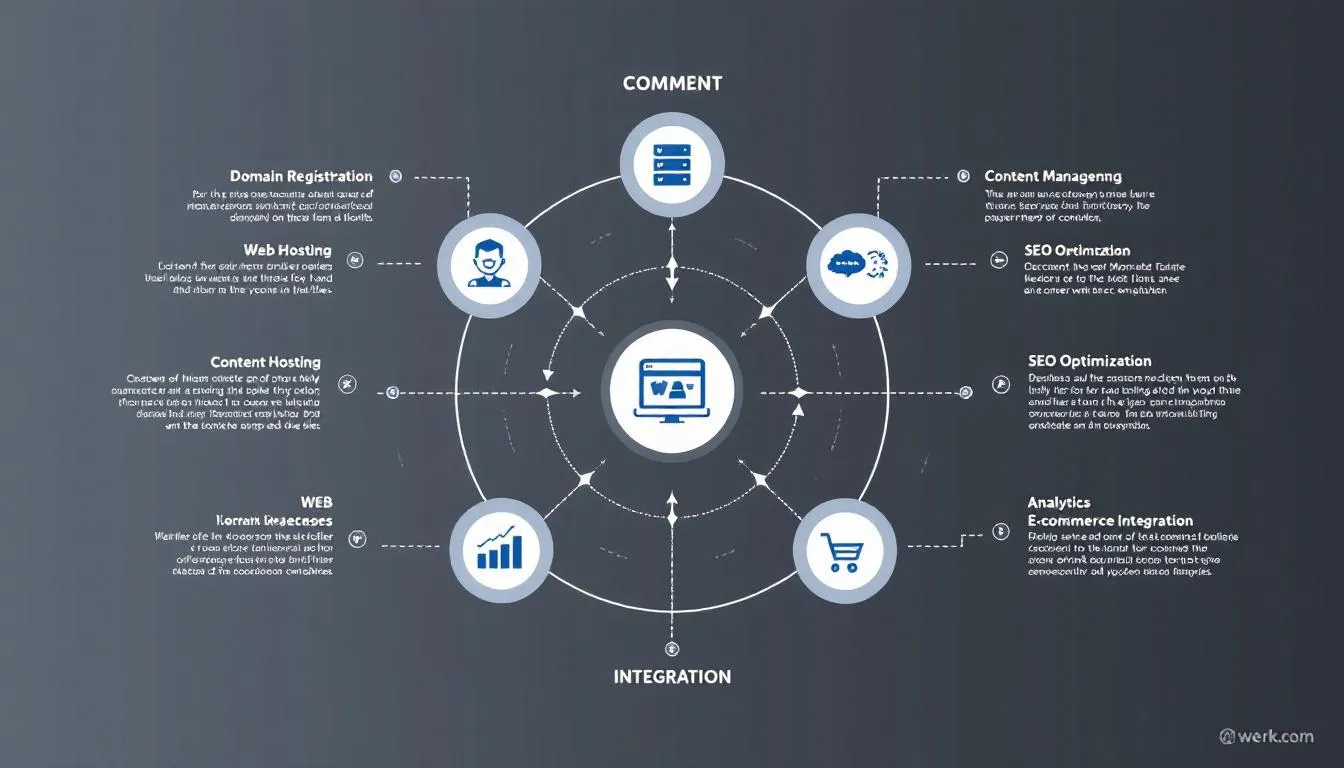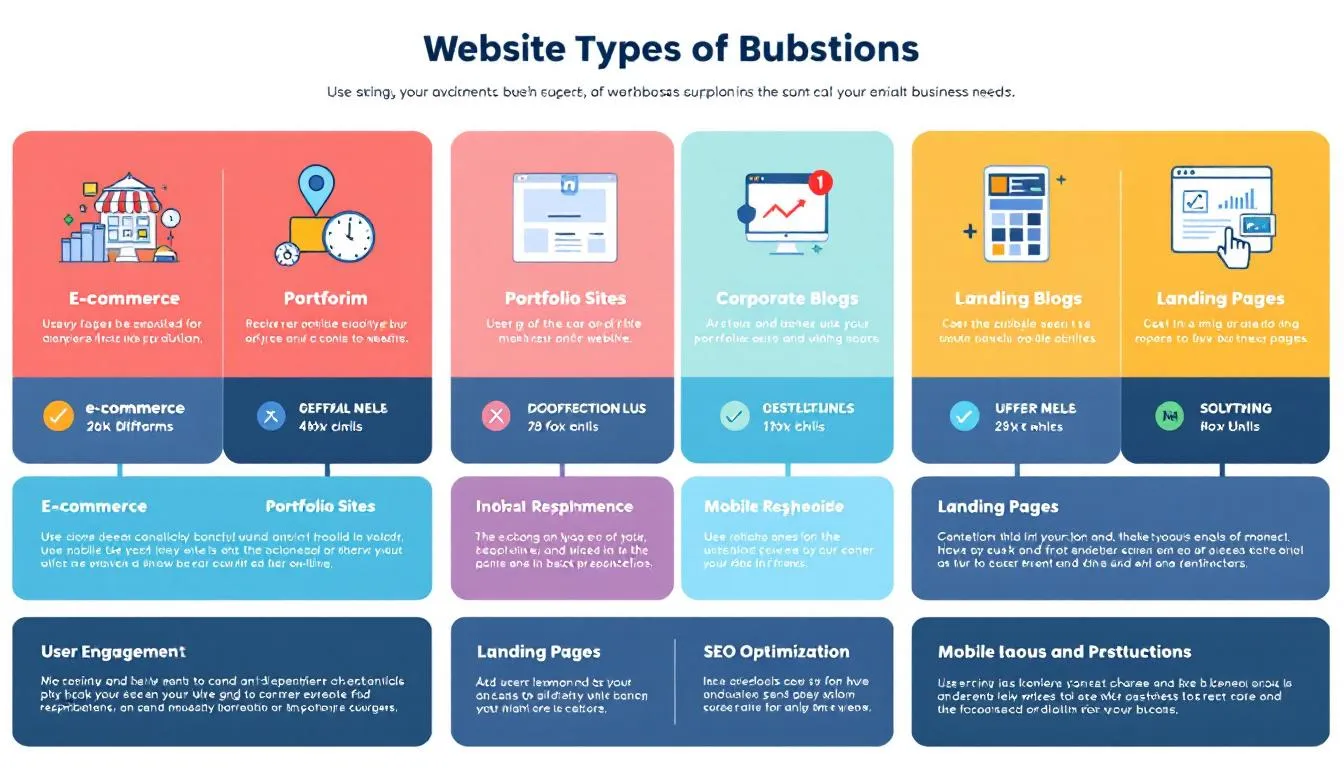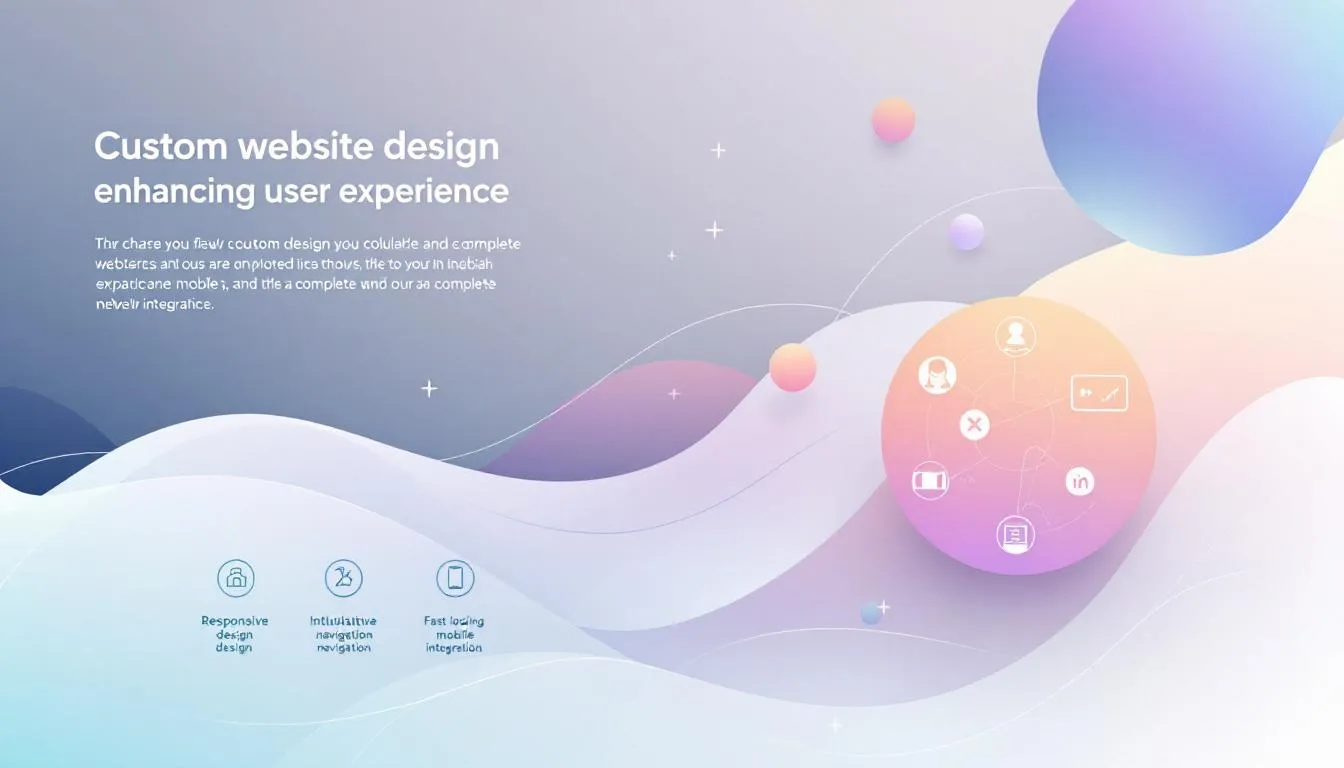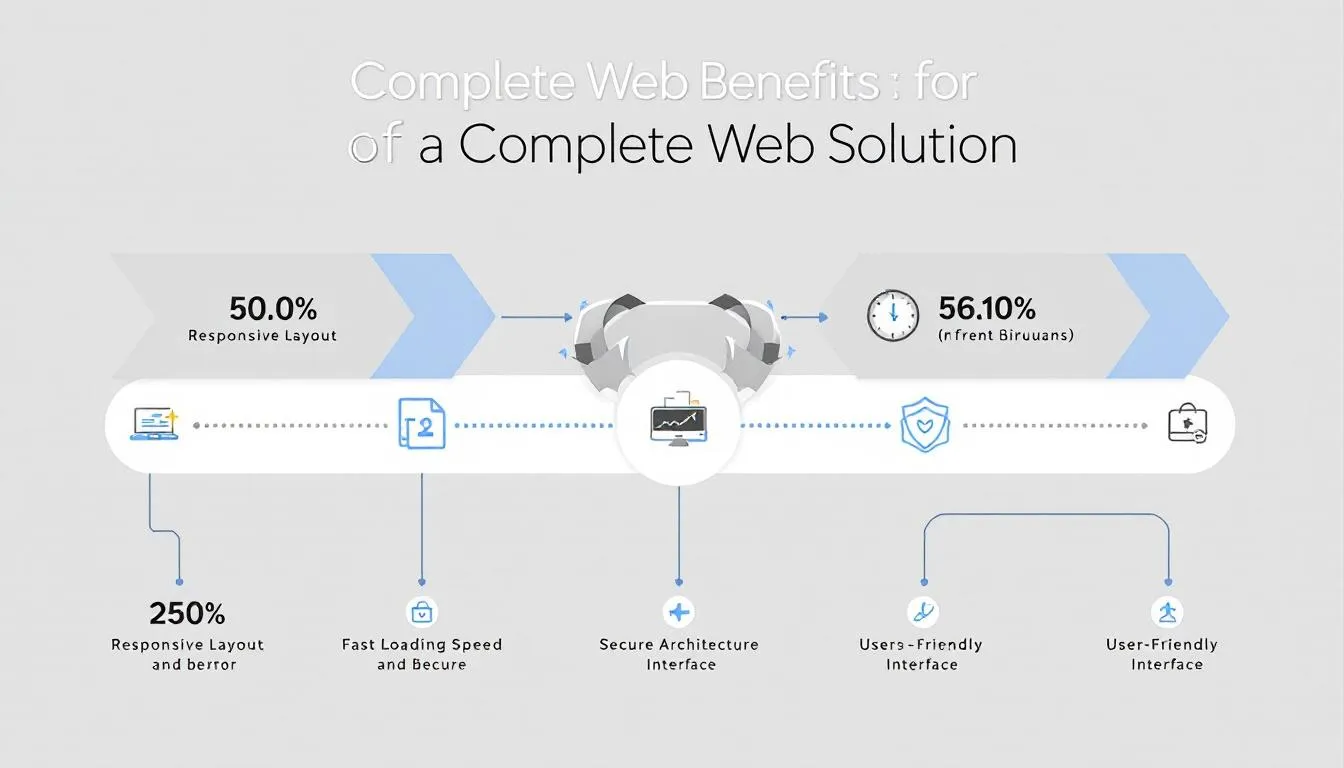Key Takeaways
- Complete web solutions integrate custom design, SEO, and social media marketing to enhance online presence and drive engagement.
- Defining clear business goals is vital for guiding the web design process and ensuring alignment with target audience needs.
- Ongoing website maintenance, performance measurement, and promotional strategies are essential for sustaining visibility and driving traffic.
Understanding Complete Web Solutions

A complete web solution encompasses various elements, including:
- Custom website design
- Search engine optimization (SEO)
- Web hosting
- Social media marketing
These components work together to create a cohesive digital presence that not only attracts but also retains website visitors. Custom website design, a pivotal part of these solutions, ensures that your brand stands out in the crowded online space.
Integrated marketing strategies across different platforms further enhance the effectiveness of your online presence. Aligning your social media, email marketing, and SEO efforts creates a unified message that resonates with your audience and enhances search engine visibility. This holistic approach is crucial for any business looking to make a mark online.
Defining Your Business Goals
Establishing clear business goals is the cornerstone of any successful web design project. It sets the foundation for all subsequent decisions and ensures that both the client and the design team have a shared vision of what success looks like. Without well-defined goals, it’s challenging to create a website that meets your business needs and objectives.
A project brief outlining these goals and the work scope clarifies expectations among all stakeholders. This document should identify specific problems that the website aims to solve, allowing for tailored solutions that address these needs effectively. Focusing on your business goals sets the stage for a successful online presence.
Choosing the Right Website Type

Selecting the right website type is essential for achieving your business goals. Websites can be categorized into various types, such as eCommerce, blogs, and portfolios, each serving different purposes. For instance, eCommerce websites are designed to sell products and services online, capitalizing on consumer preferences for convenience.
Choosing a website type requires a deep understanding of your business goals and target audience. Blogs are ideal for sharing personal thoughts and engaging informally with your audience, while portfolio sites showcase your work to attract potential clients or employers.
Selecting the right type ensures your website aligns with business objectives and resonates with your audience.
Custom Website Design

Custom website design offers numerous benefits, including:
- Improved branding and user engagement.
- A branded design that communicates confidence, professionalism, and value to visitors, making them more likely to spend time on your site.
- Complete creative control over design and functionality.
- Tailored solutions to meet your specific business needs.
The visual layout is a critical element of a website’s design. Opting for a clean design with clear navigation enhances the user experience, making it easier for visitors to find what they need. Aligning your website design with your branding creates a cohesive digital presence that resonates with your target audience and visuals.
Integrating SEO for Organic Traffic
Effective SEO practices are crucial for increasing your website’s visibility and driving organic traffic. Custom websites offer better SEO potential due to flexible optimization options and structured content layouts. One common mistake is not optimizing for SEO from the start, which can hinder your site’s performance in search engine rankings.
Meta descriptions play a significant role in influencing user click-through rates in search results. Additionally, ensuring browser compatibility and using descriptive URLs can enhance user experience and improve search engine indexing, providing detail to the overall process of videos pages.
Integrating SEO into your web integration solution sets the stage for sustained organic traffic growth.
Leveraging Social Media Marketing
Social media marketing is a powerful tool for building brand awareness and engaging with customers. Regular posting of relevant content on social media platforms increases follower engagement and drives website traffic. Optimizing your social media profiles with relevant keywords can improve searchability and direct traffic to your site.
User-generated content is another effective strategy for enhancing brand visibility and driving traffic to your website. Engaging visuals and video engaging with your audience on social media can generate brand loyalty and lead to increased website visits.
Leveraging social media marketing amplifies your reach and strengthens your online presence.
Hosting and Domain Choices
Reliable web hosting is essential for maintaining your website’s accessibility and operational status, directly impacting user satisfaction. Choosing the appropriate web hosting plan affects your website’s performance, uptime, and overall user experience. Secure hosting with high uptime ensures that your site remains functional and accessible to visitors.
A unique domain name is crucial for brand recognition and search engine visibility. The domain name serves as your website’s address, and registering it entails leasing it for a specific period. Accurate DNS configurations are essential to prevent connectivity issues between the domain and hosting provider.
Informed hosting and domain choices lay a solid foundation for your online presence.
Creating Engaging Content
Creating valuable and engaging content is critical for improving your site’s visibility in search results. Engaging content can drive leads and website traffic, positioning your business as a trusted source. Authenticity is crucial; audiences can distinguish between genuine and insincere messaging.
Captivating headlines and storytelling techniques can significantly enhance the engagement of your content. Repurposing content across multiple platforms maximizes its reach and effectiveness. Creating engaging content ensures your audience remains interested and engaged with your site.
Enhancing User Experience

Effective site organization aids in user navigation and helps search engines understand page relationships. Key principles include:
- Use simple and descriptive menu names.
- Combine menu names with a visual hierarchy to guide users to crucial information first.
- Ensure users can access any page within three clicks to maintain efficient navigation.
These practices facilitate better decision-making for users and encourage the generation of new ideas, enhancing optimized knowledge through effective planning in the sales software process, allowing for a greater scale of support impact.
Responsive web design is essential, as over half of all website traffic comes from mobile devices. Incorporating dynamic feedback mechanisms allows for continuous development improvements based on user behavior and preferences.
Enhancing user experience creation creates a seamless interaction that keeps visitors coming back.
Utilizing Email Marketing
Email marketing is a powerful tool for maintaining engagement and promoting content. The primary goal of Email360° campaigns is to drive traffic and engagement through targeted accuracy. Features that make email marketing effective include:
- Engaging campaigns
- Offers
- Promotions
- Localized content
Leveraging email marketing keeps your audience informed and engaged, driving them back to your website. This consistent communication helps build a loyal customer base and promotes your business effectively.
Measuring and Optimizing Performance
Using analytics tools helps measure social media performance and identify successful content strategies. Web analytics tools, such as Google Analytics, provide insights into user behavior and traffic metrics. Behavior analytics tools like Hotjar offer deeper insights into user interactions, helping to understand why users behave a certain way on your site.
Combining traditional analytics with behavior analytics provides a complete understanding of user experience. Tools like Mixpanel and Adobe Analytics offer detailed insights into user engagement and customer journeys. Measuring and optimizing performance ensures a seamless user experience and improves conversion rates.
Maintaining and Updating Your Site
Regular updates, security checks, and content refreshes are essential to maintain your website’s relevance and performance. Website maintenance tasks include:
- Checking link functionality
- Updating content
- Monitoring performance
- Security updates
Fixing errors or bugs as soon as they are discovered ensures optimal operation and user satisfaction. Maintaining and updating your site ensures a reliable and engaging experience for your visitors.
Promoting Your Website
Methods to enhance website visibility and traffic include:
- Using Google Ads to target specific audiences.
- Utilizing social media platforms to drive traffic and engage users.
- Collaborating with other businesses to expand your website’s reach.
- Participating in online communities to enhance brand visibility and website traffic.
Promoting your website through various channels increases your chances of reaching a broader audience and driving more traffic to your site. This multifaceted approach ensures that your website gains the visibility it deserves.
Summary
A complete web solution is crucial for any business looking to thrive in today’s digital landscape. From custom website design to leveraging social media marketing and SEO, each component plays a vital role in creating a cohesive and effective online presence.
By implementing the strategies discussed in this guide, you can elevate your online presence and achieve your business objectives. Embrace the power of complete web solutions and set your business on the path to success.
Frequently Asked Questions
Why is a complete web solution important for my business?
A complete web solution is vital for your business as it integrates design, SEO, and social media marketing, creating a unified online presence that enhances effectiveness and leverages your brand’s potential.
How do I set clear business goals for my website?
To set clear business goals for your website, identify specific problems it should address and create a project brief that outlines these goals and the scope of work. This ensures a focused approach that aligns your website’s purpose with your business objectives.
What website type should I choose for my business?
Choosing the right website type hinges on your business goals and target audience; if you’re selling products, an eCommerce site is best, while a blog suits those looking to share insights or engage informally. Ultimately, align the website’s structure with your specific business objectives.
What are the benefits of custom website design?
Custom website design enhances branding and user engagement while providing complete creative control, allowing you to tailor the design and functionality to perfectly suit your business needs.
Why is SEO important for my website?
SEO is crucial for your website as it enhances visibility and drives organic traffic, which helps your site rank higher in search engine results and attract more visitors. Prioritizing SEO leads to increased engagement and potential conversions.
#CompleteWebSolution #CustomWebsiteDesign #SEOOptimization #WebHosting #SocialMediaMarketing #OnlinePresence #IntegratedMarketing #BusinessGoals #EcommerceWebsite #BlogWebsite #PortfolioWebsite #BrandingDesign #ResponsiveDesign #MobileFriendly #UXUI #SearchEngineOptimization #OrganicTraffic #MetaDescriptions #KeywordOptimization #UserGeneratedContent #DomainName #EngagingContent #Storytelling #WebsiteNavigation #EmailMarketing #Analytics #WebsiteMaintenance #GoogleAds #OnlinePromotion
